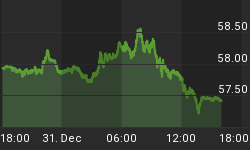We have a price target for the S&P e-Mini: the 1482-1488 area. That area is derived from Point and Figure, [P&F] used to measure market "energy," or the potential target that price can attain in a directional move. The market is already in an area where it can fail. The one caveat to any analysis pertaining to the stock market is an inability to assess market interference, [manipulation] by the central bank/Wall Street firm[s], doing everything possible to defy market gravity, and succeeding.
There were clear signs of a market sell-off, that began in earnest, starting in 2008. What was not known then was the extent to which the market would collapse. This is exactly why the Fed/Wall St has been intervening for the past year or two. They want to prevent the inevitable, inevitably making it much worse when reality is allowed to function without the artificial stimulus. Never underestimate central planners with access to unlimited fiat to boost prices.
The monthly closings in November and December, 2007, and the January high of 2008 are circled on the chart to see why the 1483+ area is potential resistance. When the P&F target area of 1482-88 is added for consideration, there is a price target synergy that merits heeding.
The resistance we mention remains potential because it must first be tested, and price must then fail, in order for a change in trend to be confirmed, and that change can be from up to just sideways. One does not act immediately upon this information by exiting long positions or establishing short positions, especially the latter. Price could stall at, and then proceed higher, or it could simply sail through that level and enter the 1500+ area. There must always be a reason for taking any action.
We rely more on horizontal support/resistance lines than trend lines because the horizontal lines are drawn from previous swing highs/lows where we know price failed at a specific area. We do have an upslanting converging triangle to show another form of potential resistance, and it happens to coincide with the horizontal and P&F numbers, giving a third independent tool for analyzing the market.
On the monthly chart, there is price synergy, but it ends on this chart. We did cover the importance of market synergy in our recent analysis of AAPL, when it failed at 700. For a comparison, see http://bit.ly/WB2vUk.

Contract changes account for the price differentiation in highs over various time frames. Current weekly price is under the monthly resistance level. The September high is the resistance area where price closed on Friday. This leaves more leeway for how high price can go on the weekly chart, and the room indicated by the channel shows just how much price can rally over 1500 before meeting channel resistance.
Last week was important. Barring an artificial price boosting, the weekly range was a poor showing for a bullish argument. In an uptrend, whenever you see a small range, especially at a potential resistance level, it says that demand is weak, unable to extend the range higher. When you compare last week's small range to the previous week's very wide range and strong close [seemingly], you have to ask, what happened to the buyers? Where did they go?
[We allude to a strong close because sometimes it can be exhaustion, and that could account for Friday's poor showing.]
Fortunately for buyers, they are a proven factor in an uptrend, and the onus is on the sellers to change market direction. However, a lack of demand, when at what appears to be an area of resistance, can embolden sellers and they become more active. We have not seen that yet, but it is important to be aware of the possibility.
There is no evidence of a market turnaround, at this point, yet there are pieces of evidence that point to potential trouble, spelled with a small "t," for now.

The daily chart hovered around the September high, seemingly offering resistance, but there was little reason to believe price would stop there. You can see the gap in price for the first trading day in January. When you view that bar, as is, and observe the next several trading days moving sideways, prior to the last two bars that rallied above 1460, price seems to be wavering. However, the story is different when the "true range" comes into play.
The true range includes the gap area from the previous close. Instead of viewing the range of 2 January as 1438 to 1458, the gap close from the previous day, 1420, makes the true range 1420 to 1458. Then, when you view the sideways activity, relative to the true range bar, there was very little "give back," or price correction, actually making the sideways move bullish. This was confirmed on Thursday, when price rallied to close at 1467.25. Then came Friday.
What happened to the buyers? Here was an opportunity to rout shorts and new sellers. It did not happen. Instead, price limped to close unchanged. Like we said about the weekly analysis, the onus is on sellers to make a statement of change. Buyers are a proven factor. Unless, or until sellers make such an altering statement, price should continue to work higher.
What everyone needs to be alert to is some kind of price weakness that does gain more recognition that demand is spent and supply is about to take over. That would come in the form of price failing at resistance with wide range bars to the downside on sharply increased volume, followed by weak, small range rally attempts, on less volume, that fails to recover lost ground. If you do not see it, do not believe that this rally is over.

















